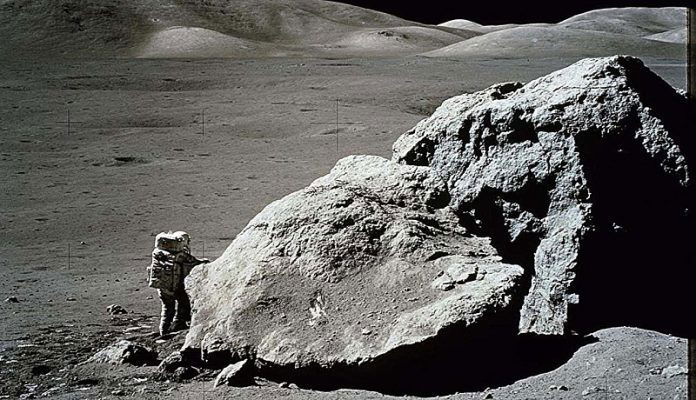
More than half a century after astronauts last set foot on the moon, the Apollo program is still offering up surprises.
A sample of lunar rock collected during the Apollo 17 mission has been opened for the first time in 50 years, and inside it may lie the story of one of the moon’s most mysterious features: the Light Mantle.
The Light Mantle is a bright, five-kilometer-long streak across the lunar surface that has fascinated scientists since it was first spotted in 1972.
Situated at the base of the towering South Massif mountain, it is thought to be the remains of a massive landslide. But what triggered it has remained an open question.
Was it an asteroid strike? Debris tumbling from the mountain? Or perhaps seismic activity deep within the moon?
Now, thanks to modern technology, researchers are finally getting the chance to look inside a sealed Apollo rock core taken from this unusual formation.
The newly opened sample is giving scientists a closer look at what happened millions of years ago when the landslide occurred.
The study was led by Dr. Giulia Magnarini, a geologist who investigates landslides on Earth, Mars, and now the moon.
She and her colleagues believe these ancient events hold valuable lessons not just for lunar science, but also for preparing future astronauts who will return to the moon through NASA’s Artemis program.
“This research continues the legacy of Apollo more than 50 years later,” Magnarini explains. “The samples were carefully preserved so we could study them with technologies that didn’t exist back then. What we’re learning now is already shaping how Artemis will collect and handle lunar material.”
Apollo 17, launched in 1972, was the final Apollo mission and remains one of the most scientifically significant. It carried Harrison Schmitt, the first trained geologist to walk on the moon, alongside commander Eugene Cernan. Together they targeted the South Massif and its Light Mantle deposit, drilling cores into the lunar soil before sealing them tightly for future study. In total, Apollo 17 returned with 110.5 kilograms of rock—more than any other mission.
At the time, scientists lacked the sophisticated tools we now take for granted. Scans were crude, and many questions could not be answered. But today, researchers use medical-grade imaging techniques, such as micro-CT scanning, to peer inside the rocks in unprecedented detail.
In the newly studied sample, scientists focused on clasts—rock fragments that broke away from the slope during the landslide. These clasts reveal how the landslide behaved once it began. Surprisingly, they found that the fine dust coating the clasts came from the fragments themselves, not from surrounding debris. This suggests the clasts shattered during the landslide, helping the mass of rock and soil to flow like a fluid rather than tumble like a rigid avalanche.
What remains uncertain is what triggered the landslide in the first place. One leading idea points to the creation of the Tycho crater, a massive lunar impact feature located far from the Light Mantle.
When Tycho formed, it sent vast amounts of material hurtling across the moon. Some of this ejecta, scientists think, may have slammed into the South Massif, destabilizing the slope and causing the landslide that spread out into the Light Mantle we see today. Evidence of secondary craters radiating from Tycho toward the South Massif supports this possibility, though more research is needed.
The findings, published in the Journal of Geophysical Research: Planets, highlight the foresight of Apollo-era planners.
NASA deliberately stored some samples untouched, anticipating that future generations of scientists would have better tools and new questions to ask. That vision has paid off, as researchers can now extract details that were unimaginable in the 1970s.
For Magnarini and her team, the work is about more than lunar geology. It’s about understanding how to prepare for the future of human exploration. Every new insight helps refine the science goals of Artemis, which will send astronauts back to the moon in the coming years.
“We often think of Apollo as history, but in many ways, its science is still alive,” Magnarini says. “These samples are time capsules, and each time we open one, we uncover another chapter of the moon’s story.”
The Light Mantle remains the only known long-runout landslide on the moon, and it continues to challenge scientists’ understanding of how such features form.
But thanks to this newly opened Apollo sample, we are closer than ever to solving the mystery of what shook the lunar mountains so long ago.



